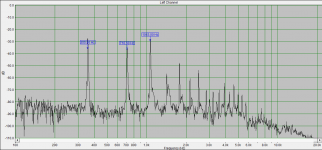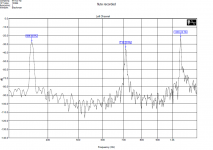Multiple instruments playing the same notes gives body, depth, warmth (whatever you want to call it) to sound, largely due to the very small discrepancies in their tuning, I wonder whether a little 2nd harmonic has a similar effect to our perception due to the non-harmonic scale? It's just a thought, also since our pitch perception is also based to a degree on the harmonic overtones of the played notes.
Whats do you call 2 oboes playing in unison? A chord.
The files that I downloaded are 16/44......?.Dan, I will check it. The 24-bit loop should tell if there is an issue.
I am sure that you know it, but for the others, when playing sound under Win7 and higher and you want to utilize 24-bit resolution, please do not forget to set 24-bit resolution for the soundcard used in the Control Panel, otherwise 16-bit is default and hirez files are converted to 16-bit resolution.
After I read Maty's comment on Direct sound, it is necessary to make this setting!
Dan.
Yes. The files in this test are in 44.1/16.
If you request 24 bit files, please try another test
Do you like tube distortion? - listening test
and make a choice of 24 bit files. They are described in the1st post of the thread.
If you request 24 bit files, please try another test
Do you like tube distortion? - listening test
and make a choice of 24 bit files. They are described in the1st post of the thread.
Last edited:
You did, when you used the word 'harmonic'.cbdb said:Who said exact.
Most overtones are not harmonic, but near to harmonics. 'Near' creates problems, which would not be present if they were exact harmonics.cbdb said:Most overtones are harmonic. A string or pipe, covers most instruments, vibrates at fractions of the length
Most overtones are not harmonic, but near to harmonics. 'Near' creates problems, which would not be present if they were exact harmonics.
Gentlemen, if you do not mind, I have just recorded a fipple flute (played myself 😀) tones and made some analysis. Maybe not "exact", but really very close. The H3 travels between 1062 and 1067 Hz.
Attachments
'Near' creates problems, which would not be present if they were exact harmonics.
could you elaborate?
Intermodulation and beat notes. Nonlinearity fed exact harmonics just generate fundamental, other harmonics and DC. Nonlinearity fed not-quite harmonics generates not quite fundamental, not quite other harmonics and LF/subsonic stuff. It is conceivable that this will make the sound 'richer', but it could also descend into mush. I seem to recall one good test for hi-fi was said to be to listen to choral music, as that has lots of nearly but not quite identical notes.
I wonder how much this test says about the inaudibility of a tube loop, and how much about the quality of Pavel's circuits and builds. 😉
yeah i guess "close"(but not exact) only counts in horseshoes and hand grenades!
sorry i don't quite follow the "Nonlinearity fed exact harmonics" thing? if you had said "Linearity fed exact..." and then " Nonlinearity fed not-quite harmonics generates not quite fundamental, not quite other harmonics and LF/subsonic stuff." it would make perfect sense to me
sorry i don't quite follow the "Nonlinearity fed exact harmonics" thing? if you had said "Linearity fed exact..." and then " Nonlinearity fed not-quite harmonics generates not quite fundamental, not quite other harmonics and LF/subsonic stuff." it would make perfect sense to me
"Exact tones" and harmonics of them may be true only for a synthesized or computer generated music, and that's why it sounds horrible 🙂. Natural instruments will always have some slight fluctuation of tone frequency and this sounds more natural to our ears, because it is natural. I would bet that instantaneous overtones are exact multiples of the instantaneous tone frequency. Applies to intermodulations as well, they are also instantaneous. We do not use crystal clocked sine generators in music, usually, speaking about acoustic instruments.
You did, when you used the word 'harmonic'.
Most overtones are not harmonic, but near to harmonics. 'Near' creates problems, which would not be present if they were exact harmonics.
Semantics. Everything Ive read about musical instruments call overtones harmonics even if not exact multiple of the fundamental. Sorry for using the term musicaly while talking about music.
Having thought about it a bit more, I now suspect that overtones will be harmonics on instruments with continuous excitation (e.g. flute) but not necessarily on those with momentary excitation (e.g. piano, guitar). Violin falls somewhere between the two, so I am not sure about that one.
PMA the Zamfir of the fipple flute...when is the album release date.
i'm still trying to figure out some of the technobabble going on.
i'm still trying to figure out some of the technobabble going on.
Gheorghe Zamfir plays Pan flute, not the wooden fipple flute. They sound quite different. His music can be easily found by google search.
Gheorghe Zamfir - Pan Flute Improvisations (CD, Album) | Discogs
Gheorghe Zamfir - Pan Flute Improvisations (CD, Album) | Discogs
must be a language thing...i did say "Zamfir of the fipple flute".(like your as good as him but on a different instrument!)
Last edited:
are fipple flute part of the class know as recorders?
and i still want to know when to expect your first album!?
and i still want to know when to expect your first album!?
There are better experts than me 😉
The Fipple Flutes: List of Musical Instruments in the Fipple Flutes Family
It looks like recorders are a part of fipple flutes family. There seem to be many versions of the terminology used. My flutes are recorders, according to this one.
The Fipple Flutes: List of Musical Instruments in the Fipple Flutes Family
It looks like recorders are a part of fipple flutes family. There seem to be many versions of the terminology used. My flutes are recorders, according to this one.
Having thought about it a bit more, I now suspect that overtones will be harmonics on instruments with continuous excitation (e.g. flute) but not necessarily on those with momentary excitation (e.g. piano, guitar). Violin falls somewhere between the two, so I am not sure about that one.
The most ridiculous thing I have heard.😱
- Home
- General Interest
- Everything Else
- Can you tell original file from tube amp record? - test

